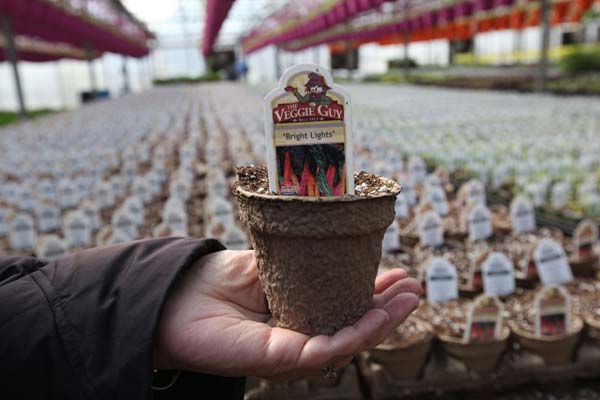
Revolutionary fibre gardening pots developed at U of T to hit shelves soon
Published: April 19, 2013
Consumers buying plants sprouting from eco-looking fibre flower pots have been buying pots which actually contain a petroleum-based product—until now.
A team of University of Toronto entrepreneurs from the Faculty of Forestry has developed a new formula to make fibre plant pots truly biodegradable. Working in collaboration with Myers Lawn and Garden Segment, they are bringing to market a green alternative to fibre pots.
“The current fibre pots you see have a petroleum product in them to give it water resistance,” said U of T forestry professor Sally Krigstin, explaining how the fibre pots don’t simply disintegrate when watered. “Our product, which is 100 per cent bio-based, has the ability to be biodegraded by organisms you’d find in a composter or in the soil.”
Krigstin affectionately refers to the product as “bio-binder,” due to its bio-based formula and the fact that it binds together the fibre pulp used in the pot.
 An official name and website are still to come but already 250,000 pots containing the new USDA-certified fibre-binding formula developed by Krigstin along with PhD student Javad Sameni and Mohini Sain, dean of forestry, have been purchased and are now in the greenhouses of a farmer near Grimsby, Ontario.
An official name and website are still to come but already 250,000 pots containing the new USDA-certified fibre-binding formula developed by Krigstin along with PhD student Javad Sameni and Mohini Sain, dean of forestry, have been purchased and are now in the greenhouses of a farmer near Grimsby, Ontario.
Bob Martin, general manager of Martin Farms in Vineland Station, Ontario, purchased the order of locally-made pots using bio-binder for his “Veggie Guy” line of premium potted plants, to be sold in the Sheridan nursery chain and independent garden centres across Ontario.
“The thing about your product is it gives us the balance of having a great pot and actually having it break down fast enough that people will visibly see it do so,” Martin told Krigstin during a visit to his greenhouse-based farm.
As Martin (pictured below) demonstrated the tomatoes, dill and "bright lights" swiss chard growing in the bio-binder pots to Krigstin and the U of T research team, he said although it does cost him a few more pennies per pot, his clients have reacted “very positively” to the new product.
“Am I taking a bit of a hit? Yes. I know I am,” he said. “But over time I think it’s worth it if my customers buy in, and I think they will because they can certainly make a good market from it.
“Demand for that Veggie Guy line has increased every year and it’s taken a big jump again this year, so we’re pushing it with this new bio-binder and I think it’ll be excellent. I would say, reality is, 90 per cent of the people that buy it haven’t a clue it’s more green than before. But we know.”
Louis Cercone, a sales representative with Myers, the company that manufactures the pots, pointed out that fibre pots have more benefits than just an eco-friendly-image.
He described the experience of one of his customers to whom he sold the slightly more expensive fibre-potted chrysanthemums ('mums) instead of those in cheaper, plastic pots.
“I said, ‘Try these ‘mums, charge more.’ When I saw him the following year, he said, ‘I’m no longer going to sell plastic.’ The ‘mums in the plastic were standing straight up. The ones in the fibre were bushy. Consumer comes in—what are they going to grab? I don’t know about you, but I want the one that looks full. Price doesn’t matter at that point.
“I think everybody out there is looking for green products and if you can prove that it’s green and go from there, customers will pay extra for it,” he said.
Krigstin’s bio-binder is certified with the USDA’s BioPreferred labeling system at 98% bio-based carbon level, as the main constituent of the binder is a waste product from papermaking.
 Receiving the USDA’s certification provides added marketing leverage for the product and opens doors for uses other than just potted plants, Krigstin says.
Receiving the USDA’s certification provides added marketing leverage for the product and opens doors for uses other than just potted plants, Krigstin says.
“This is one very small application, in our opinion, as pots,” she said. “We see the much bigger application in replacing Styrofoam in food trays, packaging.
“If we can get rid of Styrofoam out of grocery stores—that really is our vision: that we’d never see another Styrofoam tray in a supermarket.”
Sain echoed Krigstin, citing possible uses for bio-binder in fast-food pizza boxes and plastics used by food chains that are currently imported from international markets with a cheap manufacturing and labour environment.
“In today’s world, Canada and the States have a lot of competition out there, particularly from smaller countries. It is not just China anymore, it’s Cambodia, Vietnam. And when you are comparing us with the world out there, they can still make things cheaper,” he said. “The only way we can keep our livelihood and good living is to get creative ideas into commerce and that’s what we are trying to drive here.”
Sain said he is particularly proud of the bio-binder because, unlike many innovations coming from forestry that benefit industry but aren’t seen by the general public, this is something that “touches common people.”
“It’s a big jump for public awareness for us,” he said. “We want to see similar products coming out in the future.”
The dill, tomatoes and swiss chard are growing nicely, Martin said, and the bio-binder pots will ship to stores in the first week of May. He will also be demonstrating them during his Earth Day promotion at Sheridan Nurseries in Unionville on April 20 and on April 26 at Holland Park Garden Gallery in Burlington.



